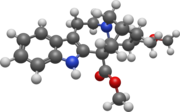
Back 18-Methoxycoronaridin German 18-Methoxycoronaridine French 18-Metoksikoronaridin Serbo-Croatian 18-Metoksikoronaridin Serbian 18-Methoxycoronaridine Swedish 18-甲氧基冠狗牙花定碱 Chinese
 | |
 | |
| Clinical data | |
|---|---|
| Other names | 18-MC; Zolunicant; MM-110; MM110 |
| Routes of administration | Oral |
| Legal status | |
| Legal status |
|
| Identifiers | |
| |
| CAS Number |
|
| PubChem CID | |
| ChemSpider | |
| UNII |
|
| CompTox Dashboard (EPA) | |
| Chemical and physical data | |
| Formula | C22H28N2O3 |
| Molar mass | 368.477 g·mol−1 |
| 3D model (JSmol) | |
| |
| |
| | |
18-Methoxycoronaridine (18-MC; developmental code name MM-110), also known as zolunicant (INN), is a derivative of ibogaine invented in 1996 by the research team around the pharmacologist Stanley D. Glick from the Albany Medical College and the chemists Upul K. Bandarage and Martin E. Kuehne from the University of Vermont. In animal studies it has proven to be effective at reducing self-administration of morphine, cocaine, methamphetamine, nicotine and sucrose.[1][2] It has also been shown to produce anorectic effects in obese rats, most likely due to the same actions on the reward system which underlie its anti-addictive effects against drug addiction.[3]
18-MC was in the early stages of human testing by the California-based drug development company Savant HWP before being acquired by MindMed, a Canadian pharmaceutical company newly listed on the NASDAQ in April 2021.[4][5] In 2002 the research team began raising funds for human trials, but were unable to secure the estimated $5 million needed.[6] In 2010, Obiter Research, a chemical manufacturer in Champaign, Illinois, signed a patent license with Albany Medical College and the University of Vermont, allowing them the right to synthesize and market 18-MC and other congeners. In 2012 the National Institute on Drug Abuse gave a $6.5 million grant to Savant HWP for human trials.[5] In 2017 it went into Phase-II trials in Brazil for treatment of Leishmaniasis at the Evandro Chagas Institute,[7] but not for approval for use as a treatment for drug addiction. A phase 2a study of MM-110 treatment in patients experiencing opioid withdrawal is set to commence in Q2 2022.[8]
- ^ Glick SD, Kuehne ME, Maisonneuve IM, Bandarage UK, Molinari HH (May 1996). "18-Methoxycoronaridine, a non-toxic iboga alkaloid congener: effects on morphine and cocaine self-administration and on mesolimbic dopamine release in rats". Brain Research. 719 (1–2): 29–35. doi:10.1016/0006-8993(96)00056-X. PMID 8782860. S2CID 6178161.
- ^ Glick SD, Sell EM, Maisonneuve IM (December 2008). "Brain regions mediating alpha3beta4 nicotinic antagonist effects of 18-MC on methamphetamine and sucrose self-administration". European Journal of Pharmacology. 599 (1–3): 91–5. doi:10.1016/j.ejphar.2008.09.038. PMC 2600595. PMID 18930043.
- ^ Taraschenko OD, Rubbinaccio HY, Maisonneuve IM, Glick SD (December 2008). "18-methoxycoronaridine: a potential new treatment for obesity in rats?". Psychopharmacology. 201 (3): 339–50. doi:10.1007/s00213-008-1290-9. PMC 3787601. PMID 18751969.
- ^ Mindmed Acquires Opioid Addiction Drug Candidate Based on the Natural Psychedelic Ibogaine newswire.ca September 16, 2019.
- ^ a b Albany Med scientist closer to addiction drug success timesunion.com June 27, 2014.
- ^ Addiction Treatment Strives for Legitimacy. Journal of the American Medical Association. 2002; 288: 3096-3101.
- ^ "Phase 2 Trial to Evaluate 18-Methoxycoronaridine Efficacy, Safety and Tolerability in Cutaneous Leishmaniasis Patients". ClinicalTrials.gov. Retrieved 19 February 2020.
- ^ "Opioid Use Disorder: Zolunicant's Potential for Unmet Treatment Needs". MindMed.co. 20 May 2022. Retrieved 23 May 2022.